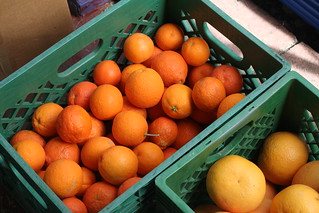Can “electronic sensor circuits” reduce food waste by judging food freshness (through measuring acidity levels) more accurately than expiration dates? Yes. But…
-But that’s not saying much, as expiration dates aren’t all that accurate.
-But so could your own sensors–of smell, sight and taste.
-But these food sensors are currently too expensive for mainstream adoption.
-But, the advent of plastic sensors could make them economically feasible in 5 years!
There is some precedent for using this technology, as sensors are currently used at the pallet level to track temperature during shipping and unloading. And there are already freshness sensors  to detect gases given off by meat and fruit.
Yet, it remains to be seen when the new plastic, inexpensive sensors will be ready and whether industry and consumers will adopt it. In the meantime, we still have that oh-so-elegant, low-tech sensor: the old sniffer.Â


 These days, Iskashitaa  volunteers–a mix of refugees and Tucson lifers–rescue
These days, Iskashitaa  volunteers–a mix of refugees and Tucson lifers–rescue 